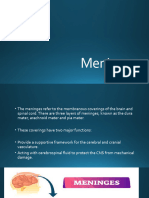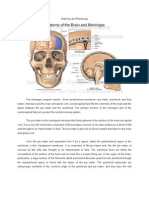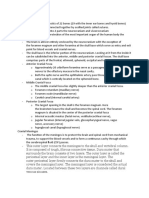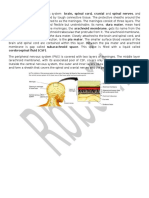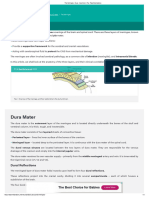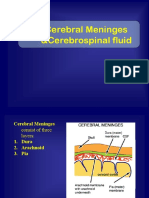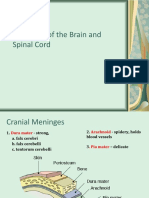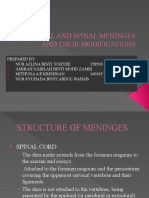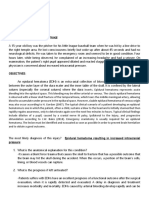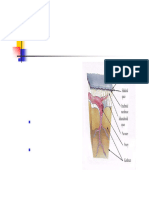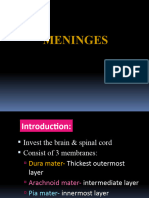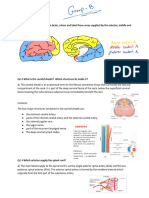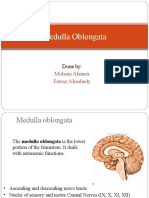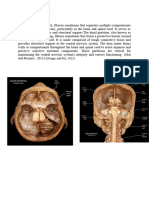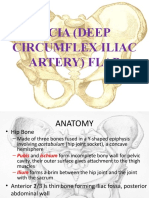Man On
Man On
Uploaded by
Rohit SharmaCopyright:
Available Formats
Man On
Man On
Uploaded by
Rohit SharmaCopyright
Available Formats
Share this document
Did you find this document useful?
Is this content inappropriate?
Copyright:
Available Formats
Man On
Man On
Uploaded by
Rohit SharmaCopyright:
Available Formats
Manon
Epidural, subdural, and subarachnoid hemorrhages are best understood by reviewing the
anatomy of the meninges (membrane coverings of the brain):
The meninges are divided into three layers: the dura mater, arachnoid, and pia mater. The
outer layer, the dura mater, lines the inner surfaces of the skull and forms several reflections
that partially separate the cerebral hemispheres along the midline (interhemispheric fissure)
and the cerebrum from the cerebellum. The dura mater is rather firmly adherent to the skull,
particularly at the junctions (cranial sutures) of the various bones which comprise the skull.
The potential space between the skull and the dura mater is referred to as the epidural
space. A hemorrhage into this space is referred to as an epidural hemorrhage. These
hemorrhages are usually the result of a tear in a meningeal artery.
The middle layer of the meninges is the arachnoid. It is a thin membrane likened in
appearance to a spider's web. Under normal conditions, the arachnoid is attached to the
overlying dura. The potential space between the dura mater and the arachnoid is the
subdural space. A hemorrhage into this space is referred to as a subdural hemorrhage. These
hemorrhages are usually the result of a tear in one of the small veins which traverses the
space between the brain and the dura mater (bridging veins).
Finally, the pia mater is the innermost layer. It is delicate and intimately adherent to the
surface of the brain. The space between the arachnoid and the pia mater is the subarachnoid
space. A hemorrhage into this space is referred to as a subarachnoid hemorrhage.
Epidural, subdural, and subarachnoid hemorrhages are sometimes referred to as extra-axial
hemorrhages, indicating that they occur outside the substance of the brain. Although all
three types of hemorrhage may occur with non-accidental trauma, the classic intracranial
hemorrhage seen in Shaken Baby Syndrome is the subdural hemorrhage. In this setting, the
subdural hemorrhage is often bilateral or located in the posterior interhemispheric fissure.
(Answer provided by John Lancon, M.D., Assistant Professor of Neurosurgery at the
University of Mississippi Medical Center, Jackson, MS.)
over a year ago
You might also like
- Meninges PPT NPDocument21 pagesMeninges PPT NPEmshellr RomeNo ratings yet
- Anatomy and Physiology of HydrocephalusDocument3 pagesAnatomy and Physiology of HydrocephalusCherry Oña Antonino100% (1)
- MeningesDocument28 pagesMeningesayesha rajputNo ratings yet
- Anatomy and PhysiologyDocument2 pagesAnatomy and PhysiologyKamille Jeane Stice CavalidaNo ratings yet
- MENINGES - Anatomy of Dura Matter, Pia MatterDocument34 pagesMENINGES - Anatomy of Dura Matter, Pia MatterfidhavfathimaNo ratings yet
- Brain Spinal Cord Cerebrospinal Fluid Nervous System Pia Mater Membrane TissueDocument2 pagesBrain Spinal Cord Cerebrospinal Fluid Nervous System Pia Mater Membrane TissuelecturioNo ratings yet
- NVS MeningesDocument5 pagesNVS Meningesdncm.alejandroNo ratings yet
- 05 Cranial Cavity in Part 1Document27 pages05 Cranial Cavity in Part 1ilagernischit321No ratings yet
- MeningesDocument23 pagesMeningeskainat karimNo ratings yet
- The SkullDocument6 pagesThe SkullKeeping up with ania kokoNo ratings yet
- MeningensDocument2 pagesMeningenslianurliaNo ratings yet
- Brain Anatomy FunctionsDocument1 pageBrain Anatomy FunctionsRbbani AwanNo ratings yet
- Epidural Space - Lies Between The Dura and The Vertebral BonesDocument4 pagesEpidural Space - Lies Between The Dura and The Vertebral BonesDaniel DanielNo ratings yet
- Hematoma EpiduralDocument6 pagesHematoma EpiduralAngel Jhosue MarmanilloNo ratings yet
- GRDA Intro Brain Cranial Nerves P2Document7 pagesGRDA Intro Brain Cranial Nerves P2KingNo ratings yet
- There Are 3 Layers of Tissue Called MeningesDocument2 pagesThere Are 3 Layers of Tissue Called MeningesJordz PlaciNo ratings yet
- Ns1 Assignment 2 Meninges Group 1Document4 pagesNs1 Assignment 2 Meninges Group 1Roselle AbrazaldoNo ratings yet
- Anatomy and PhysiologyDocument1 pageAnatomy and PhysiologyDARLENE ROSE BONGCAWILNo ratings yet
- The Meninges - Dura - Arachnoid - Pia - TeachMeAnatomyDocument4 pagesThe Meninges - Dura - Arachnoid - Pia - TeachMeAnatomyraihaana turawaNo ratings yet
- Cerebral Meninges &cerebrospinal FluidDocument40 pagesCerebral Meninges &cerebrospinal FluidНемосјановић ЋудмилаNo ratings yet
- MeningesDocument25 pagesMeningesAsad OsmanNo ratings yet
- Meninges وهدانDocument10 pagesMeninges وهدانوسيم جمال مياسNo ratings yet
- 2-Meninges and SinusesDocument62 pages2-Meninges and SinusesMajd HallakNo ratings yet
- Presentation SHW 32oo, Isnin NiDocument23 pagesPresentation SHW 32oo, Isnin NiAmibella Amirah NabilahNo ratings yet
- Meninges: Consist of Three LayersDocument23 pagesMeninges: Consist of Three LayersShantu ShirurmathNo ratings yet
- Meninges Dura, Arachnoid, Pia, Meningeal Spaces KenhubDocument1 pageMeninges Dura, Arachnoid, Pia, Meningeal Spaces KenhubANo ratings yet
- The Radiology Assistant Traumatic Intracranial HemorrhageDocument1 pageThe Radiology Assistant Traumatic Intracranial HemorrhageMahmudah AlkatiriNo ratings yet
- YU - CNS - Meninges and CSFDocument70 pagesYU - CNS - Meninges and CSFgtaha80No ratings yet
- Juan Emilio Cuesta XII - Turing B Anatomy and Physiology Case Study #3Document5 pagesJuan Emilio Cuesta XII - Turing B Anatomy and Physiology Case Study #3Antonio NoblezaNo ratings yet
- 04 - Meninges - DR Najeeb NeuroanatomyDocument18 pages04 - Meninges - DR Najeeb Neuroanatomyhiba jasimNo ratings yet
- MENINGES VENTRICLES CEREBROSPINAL FLUID andDocument18 pagesMENINGES VENTRICLES CEREBROSPINAL FLUID anddanNo ratings yet
- Bau Dent2008 Meninges and Venous Sinuses 2023Document33 pagesBau Dent2008 Meninges and Venous Sinuses 2023rozhinajalili1381turkeyNo ratings yet
- 07 GeneralDocument13 pages07 GeneralMalinda KarunaratneNo ratings yet
- Neuro AnatomyDocument49 pagesNeuro AnatomyShalini SinghNo ratings yet
- The Meninges and The Cerebrospinal Fluid: Bagian Anatomi Fkik-Uin Alauddin MakassarDocument23 pagesThe Meninges and The Cerebrospinal Fluid: Bagian Anatomi Fkik-Uin Alauddin MakassaryuyuNo ratings yet
- Skeletal SystemDocument18 pagesSkeletal Systemziya4hmad.9258No ratings yet
- Department of Anatomy College of Medicine University of Ibadan Neuroanatomy Dissection of The BrainDocument22 pagesDepartment of Anatomy College of Medicine University of Ibadan Neuroanatomy Dissection of The BrainAbdulateef AdebisiNo ratings yet
- MeningesDocument43 pagesMeningesRehab NaeemNo ratings yet
- Nervous SystemDocument29 pagesNervous Systemgitixo7128No ratings yet
- BAB 2 OK BGTTDocument25 pagesBAB 2 OK BGTTanshariNo ratings yet
- Central Nervous SystemDocument102 pagesCentral Nervous SystemDrJayakumar MohanNo ratings yet
- Anatomy-Cerebral AneurysmDocument1 pageAnatomy-Cerebral AneurysmLeslie Noreen AguilarNo ratings yet
- Anatomy and Physiology For Bacterial MeningitisDocument4 pagesAnatomy and Physiology For Bacterial MeningitisynecesityNo ratings yet
- Meninges of The BrainDocument42 pagesMeninges of The Brainchochojk36No ratings yet
- ABUTHSON NS Part 2Document21 pagesABUTHSON NS Part 2ruthdanson10No ratings yet
- Lecture Notes in NeuroanatomyDocument752 pagesLecture Notes in NeuroanatomyDenver NcubeNo ratings yet
- Online Practice Tests, Live Classes, Tutoring, Study Guides Q&A, Premium Content and MoreDocument26 pagesOnline Practice Tests, Live Classes, Tutoring, Study Guides Q&A, Premium Content and MoreJSlinkNYNo ratings yet
- Online Practice Tests, Live Classes, Tutoring, Study Guides Q&A, Premium Content and MoreDocument26 pagesOnline Practice Tests, Live Classes, Tutoring, Study Guides Q&A, Premium Content and MoreYoAmoNYCNo ratings yet
- 01 25 Ventricles-NOTESDocument3 pages01 25 Ventricles-NOTESPriyoshi KunduNo ratings yet
- Cranial Cavity Dural Venous Sinuses and Pituatory GlandDocument14 pagesCranial Cavity Dural Venous Sinuses and Pituatory GlandvaishnavichellapandiyanNo ratings yet
- Brain - Meninges: Overview of The MeningesDocument6 pagesBrain - Meninges: Overview of The MeningesAllison100% (1)
- Human Anatomy: Brain and Cranial NervesDocument127 pagesHuman Anatomy: Brain and Cranial NervesDr.G.Bhanu PrakashNo ratings yet
- Bacterial MeningitisDocument3 pagesBacterial MeningitisDANIELLA MALARANG MELNo ratings yet
- MeningesDocument27 pagesMeningesSefrinmi AyodejiNo ratings yet
- Session2 ActivitiesDocument6 pagesSession2 ActivitiesahmaddlerchessNo ratings yet
- Medulla Oblongata: Mohsen Alenezi Fawaz AlreshedyDocument22 pagesMedulla Oblongata: Mohsen Alenezi Fawaz AlreshedyMhsnNo ratings yet
- Biomechanics of Peripheral and Spinal Nerve RootsDocument86 pagesBiomechanics of Peripheral and Spinal Nerve RootsJawad HassanNo ratings yet
- Seminar IntroductionDocument8 pagesSeminar IntroductionMiracle KosisochukwuNo ratings yet
- Dcia (Deep Circumflex Iliac Artery) FlapDocument43 pagesDcia (Deep Circumflex Iliac Artery) FlapRohit SharmaNo ratings yet
- Erb's PointDocument14 pagesErb's PointRohit SharmaNo ratings yet
- Erb's PointDocument14 pagesErb's PointRohit SharmaNo ratings yet
- Trigeminal Neuralgia and Its ManagementDocument79 pagesTrigeminal Neuralgia and Its ManagementRohit SharmaNo ratings yet


